
Shortcomings in Europe in human capital, data and the financing available all hold up adoption by European firms of artificial intelligence. These same barriers also constrain European AI research and development. Table 1 shows how barriers in terms of skills, financing and data come into play differently at each of the three stages of innovation (see our recent Policy Contribution for a detailed discussion).
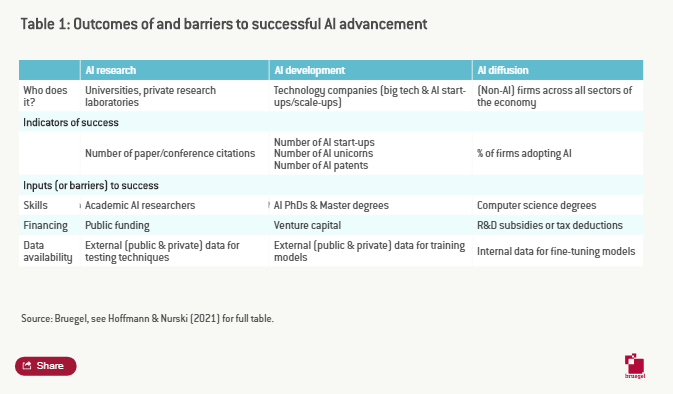
A head-start in AI research, development and diffusion can generate economic and geopolitical benefits. Rapid AI adoption in the private sector promises productivity gains and a competitive edge on global markets. Growing demand for AI technologies will generate economic benefits in countries that are home to developers of cutting-edge AI products. AI development also arguably reinforces strategic autonomy by reducing dependence on foreign technology and providing opportunities for policymakers to shape international standards. Countries affiliated to scholars conducting frontier AI research may benefit from knowledge transfers to students and spillovers to the private sector, and the ability to set research priorities through policy. Unsurprisingly, more than 30 countries now have national AI strategies, including the US and China
AI innovation outcomes in the EU, the US and China
Measuring advancement requires different metrics for the three stages of innovation – research, development and diffusion. AI research can be considered successful when it leads to journal and conference citations; AI development can be considered successful when it leads to patents or unicorns (start-up companies valued at $1 billion or more); and AI diffusion can be considered successful when firms pilot or integrate AI into their operations. In each of those areas, Europe is proving less successful than its international counterparts (Figure 1). Europe's skills, data and financing shortcomings contribute to this.
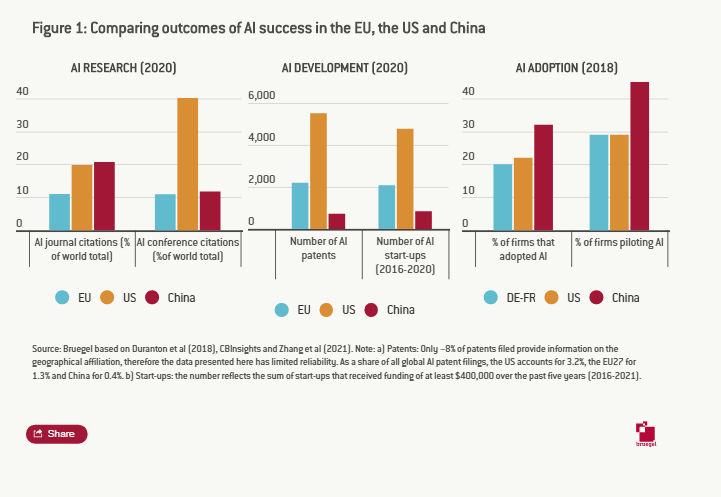
AI skills availability in the EU, US and China
A skilled labour force is a key enabler of technological advancement. Competitive universities and academic talent enable countries to participate in frontier research. Skilled researchers generate productivity and quality spillovers to their teams and co-authors. High levels of intellectual capital and skills have been found to boost innovation performance in high-tech firms, and the number and success of AI start-ups depend on the specialised expertise of their founders. Finally, the availability of digital skills among staff is central to AI adoption. Four-fifths of EU companies consider the lack of skills in the labour force to be a critical barrier to AI adoption.
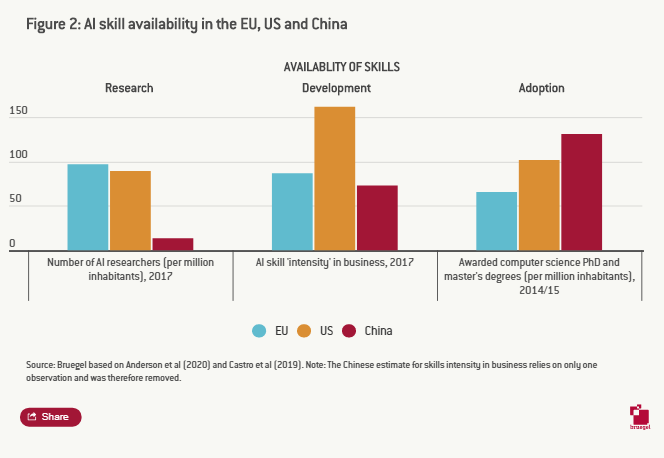
The metrics shown in Figure 2 reflect skill endowments of the three economies for each stage of AI advancement. The EU has an excellent skills base in terms of AI research (column 1), but appears to have less of an advantage when it comes to leveraging this expertise in the private sector. The indicator for skill intensity in business shows that the EU has on average less than half as many AI researchers employed in top AI firms than the US. Moreover, the ability of EU firms to adopt AI systems and adjust them to their operational needs is limited by the relatively low availability of programmers and data engineers in the labour market, as proxied by the number of computer science degrees (column 3). Here, in line with the AI adoption estimates, the Chinese labour force appears better equipped to serve the needs of business.
Data availability in the EU, US and China
Data availability is the second important driver of AI advancement. The ability to process and store huge amounts of data has been one of the key enablers of recent AI research and development. Combined with advancements in scalable computer systems, the emergence of massive amounts of (public and private) data have allowed core AI algorithms, such as deep learning and reinforcement learning, to be explored at unprecedented scale and scope. For AI adoption by regular companies, however, the availability of internal company data is a more crucial determining factor, as AI technologies need to be fine-tuned to the specific context of each organisation. This algorithmic fine-tuning requires adoption of previous "basic" technologies such as data storage and computing power, because, unless data can be collected, stored and transformed, companies cannot begin to learn from it or use it to support intelligent decision making. More than half of EU companies have cited lack of internal data as a major or minor obstacle to AI adoption.
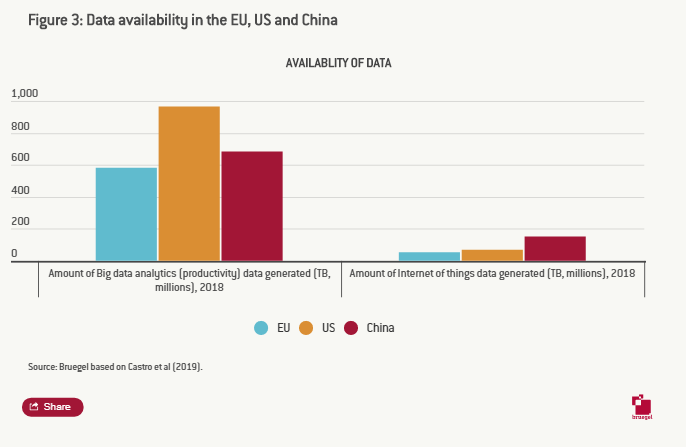
The availability of data in digital form is determined by both the amount of data generated and its accessibility to researchers and companies. Large datasets of productivity data and data generated from connected devices and appliances can, for example, be used to train machine-learning algorithms in retail or industrial settings and are especially relevant to AI research and development. Data generation in the EU is significantly lower than in the US and China (Figure 3), likely driven by low levels of digitisation in European economies. Unfortunately, lack of information on firm-level data collection prevents us from making comparisons about internal data availability.
AI financing in the EU, US and China
Intuitively, access to financing is crucial for AI start-ups to scale-up and realise their ideas. Venture capital appears particularly suited to fill this gap since, in addition to providing funding, VC investment is associated with beneficial impacts on firms' operations. Similarly, financial constraints are a major barrier to technology adoption in regular non-AI firms. Complex technologies such as AI require significant operational and organisational adjustments, , the costs of which can be prohibitively high for some firms. Governments wishing to stimulate AI adoption should consider subsidies or tax incentives.
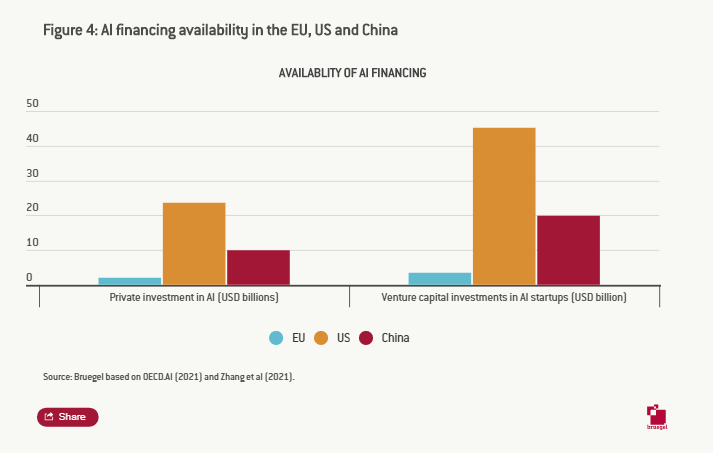
Compared to American and Chinese counterparts, European firms face dire budget constraints when it comes to AI (Figure 4). In 2020, VC flows into EU start-ups represented less than one quarter of the flows to China, and less than one tenth of those to the US. The same is true for private investment in AI. According to the OECD's AI Policy observatory, based on 13 government agencies, total public AI R&D funding stood at $3.6 billion in 2019, the vast majority accounted for by US and EU spending (data on Chinese public R&D investment is not available for comparison).
Policy recommendations
Compared to China and the US, lack of financing seems to be the most crucial barrier that Europe faces overall. Acquisition of the technology and adaptation of operational processes around AI prove constraining for regular businesses. International comparisons often focus on the EU's shortfall in VC investment in AI, which is crucial for AI development. But to stimulate adoption of AI among regular non-tech firms, governments might better look to tax deductions or subsidies that support the acquisition of AI technology and related services.
Lack of availability of AI skills seems the main factor holding back the final adoption of AI in regular firms. International comparisons show that despite the EU's large number of academic AI researchers, Europe doesn't deliver the same amount of skilled labour to private firms, resulting in a lack of skilled data scientists who can put AI to practical commercial use. This suggests that the labour market is a binding constraint on AI adoption and an area to which the EU and member states should pay attention. Improving opportunities for adult learning and making data skills part of more educational curriculums are the first steps to take.
Finally, in terms of data availability, data generation in the EU appears to be trailing behind the US and China, a result of Europe's lagging digital transformation of businesses and public administration. While access to external (private and public) data is necessary for AI research and development, the availability of internal company data is more crucial for AI adoption by non-R&D-firms – for example, fine tuning of AI algorithms for the purposes of specific businesses. Governments should therefore first promote the digitisation of business and administration, and support the investments needed to improve technological readiness necessary for AI adoption. Next, policymakers can focus on opening up public (anonymised) data and improving cross-country accessibility and comparability of datasets.
Alleviating these most pressing constraints in terms of skills, financing and data would go a long way to promote AI advancement in Europe.
今年1月,新冠疫情突然而至。为了防止疫情扩散,我国采取了史无前例的交通阻断及人流限制措施,这也为我国农业农村经济发展带来了巨大挑战。

The Xinhua Institute, a think tank affiliated with Xinhua News Agency, on Friday issued a report in Kuala Lumpur, capital of Malaysia, titled "RCEP and the Vision of the Maritime Silk Road: New Frontiers for China-ASEAN Cooperation."
2025-04-14